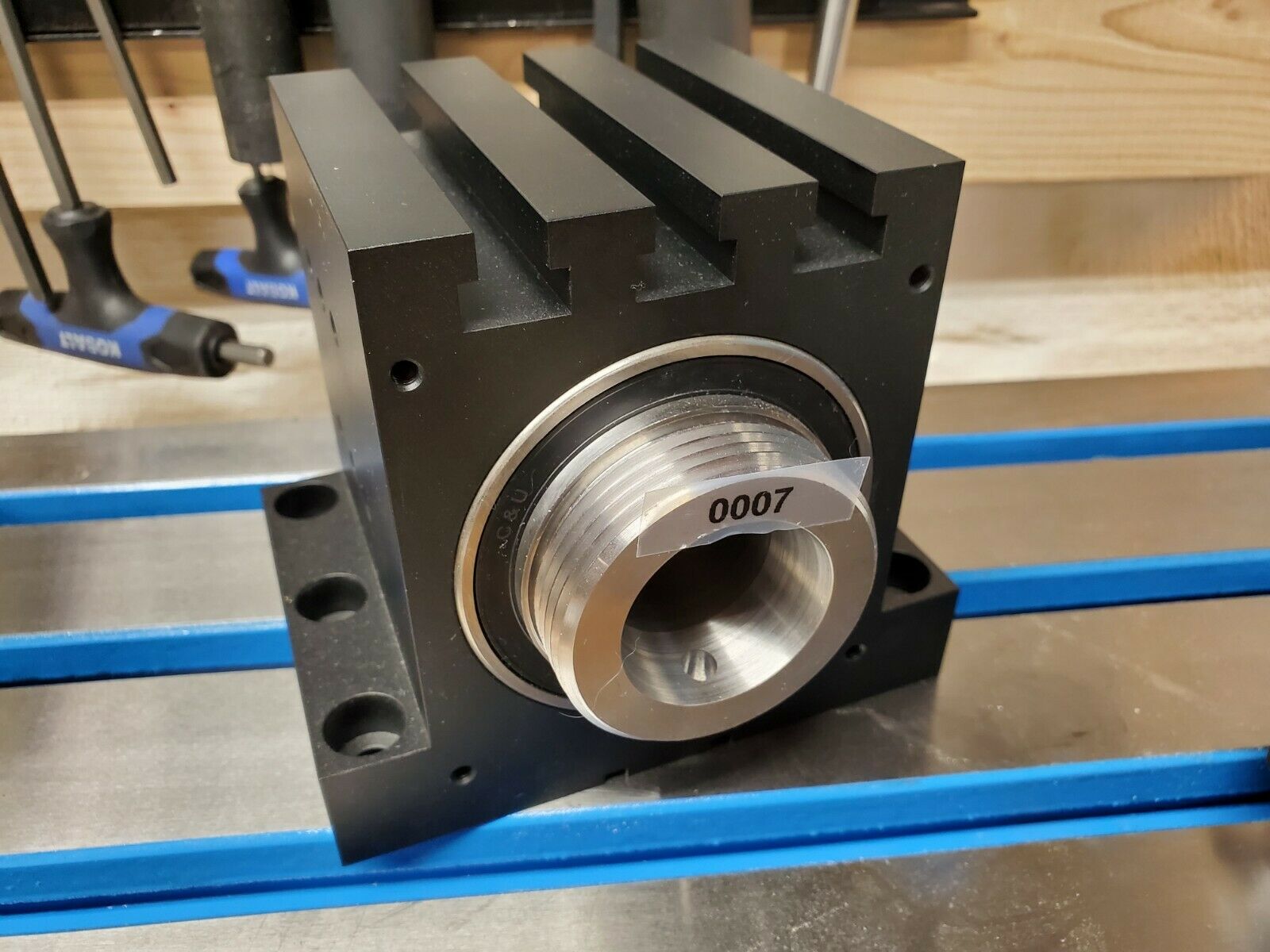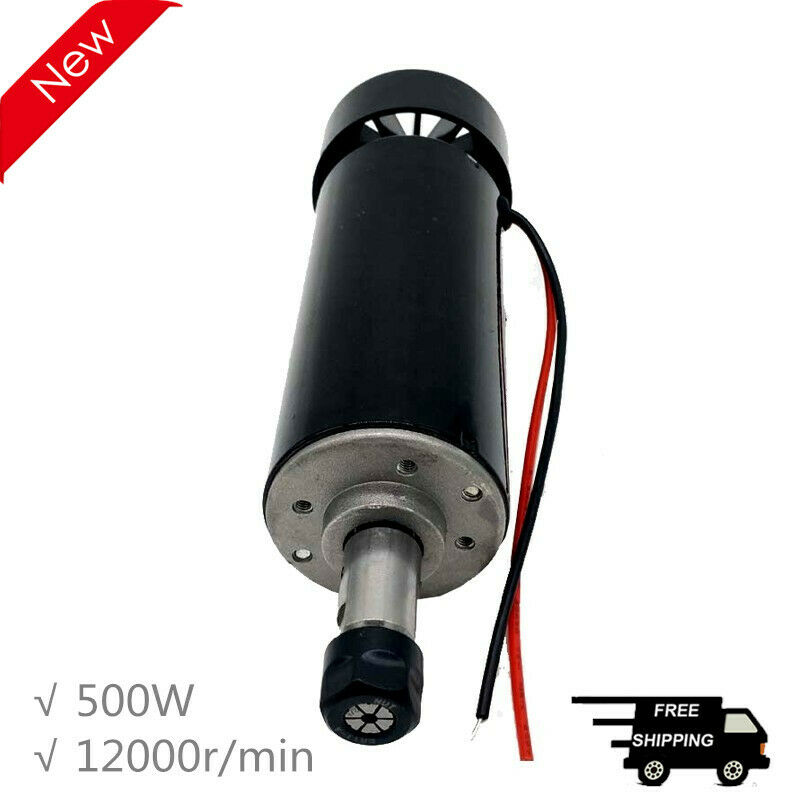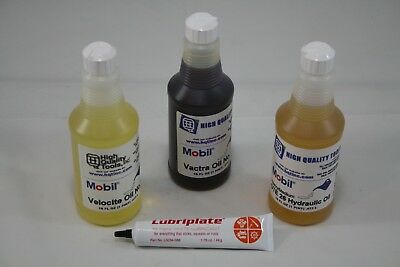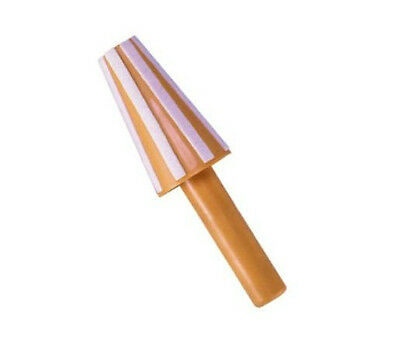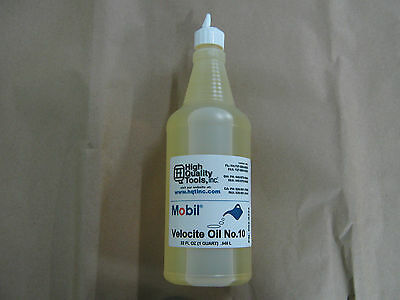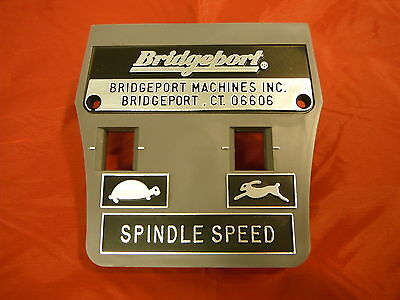-40%
BT-30 Taig-Sherline Headstock - Scratch-N-Dent Sale!
$ 288.81
- Description
- Size Guide
Description
Why is this a Scratch-N-Dent:While filling orders for the BT-30 headstocks, this spindle arbor somehow got put on the good inventory shelf...so, it got assembled and then I noticed the runout was off...0.0007" runout (normal is 0.0005 or less). Because ABEC-7 deep groove bearings are so expensive, I didn't want to destroy a perfectly good set of bearings trying to remove them. The runout is in the spindle arbor, not the bearings. So, it could be ground while still mounted and get the runout down to .0002" or less if one chose to do that. That being said, just know that grinding isn't cheap.
Here's your chance to own a BT-30 headstock for your Taig or Sherline mill....at a reduced price of just 7
Below is the basic BT-30 info:
Introducing The GlockCNC BT-30 Headstock!
Are you looking for the ultimate in precision and rigidity for a small headstock? Do you like the idea of quickly changing out tools? Then this is for you... You can now be among the first to get the GlockCNC BT-30 ATC Ready headstocks for Taig, Sherline, Chinese Mini Mill or custom mills. Until now, there were no bolt on headstocks that allowed for commercial grade 30 taper tooling. One of the great parts about owning a BT-30 headstock is the tooling availability. BT-30 tooling is very inexpensive for extremely high precision, tons of tooling types available and even lots of great quality used BT-30 tools available, if you want to go that route.
Is a BT-30 Taper Headstock Overkill For a Small Machine?
Initially, I wondered the same thing. Then I came up with the simple (if not obvious) solution...use bigger bearings that allow the tooling to fit deep up into the spindle bearings. By the time we finished engineering the whole thing, the headstock casing ended up being just 95mm (less than 4” tall) with minimal tool “stick-out” to conserve Z axis space. Yes, this is bigger than the stock Taig or Sherline headstock, but the payoff is huge by comparison.
Is There Any Advantage to the BT-30 System Over the R8 System?
We’ve done plenty of testing to answer that very question. As it turns out, there’s better vibration dampening, better finish quality and more precision...and here’s why;
Long Tool Taper
- By using two good size Internal Dimension stacked bearings, we were able to fit almost the entire BT-30 tool taper up inside the bearings (a 3rd bearing holds the tail section of the spindle arbor). This my friend, puts the tooling load inside of the bearings, where all the work is being done...and frankly, that’s where the taper should be, high up into the bearings. (Take a look at the first image up to the right side on this page. See how far the tooling taper goes into the bearings? It actually goes a little further than what is shown, the 3D printed plastic spindle arbor shrank a little and didn't allow the tool to seat as far up as possible.) This is a significant advantage over an R8 spindle arbors. Most R8 spindles arbors hold the collet or tooling
below
the bearings...which is exactly where you don’t want it...especially on a smaller mill. Because most R8 spindle arbors hang well below the bearings, it acts like a lever putting a heavy angular load on the bearing for sideways cutting.
Tooling & Spindle Mass
- BT-30 tooling is simply more robust than R8 tooling. Some may argue that the taper on both the BT-30 and R8, at the widest point, is close to the same and may not make a difference. However, there's more to the story than taper width. Testing shows the larger tooling mass, far longer taper, and larger spindle arbor for the BT-30 results in far better rigidity and vibration dampening. Once the BT-30 tool is seated in the spindle, the entire spindle now becomes one nice solid chunk of metal ready to do some real precision work.
Tooling Precision
- Nowadays, anybody can find inexpensive BT-30 tooling good from 0.0001” to 0.0002” TIR (.0025mm to .004mm)...by comparison, most good R8 collets are .0005” to .0006” TIR. That means R8 tooling is 3 to 6 times less accurate than good BT-30 tooling! Simply put, you can find much more accurate tooling for BT-30 systems.
Tooling Variety
- True, there is a lot of tooling for R8 spindles. However, your new BT-30 headstock will open you up to even more tooling options..including modular cutters. Plus, as mentioned before, the tooling offers much more precision than comparable R8 tooling.
Made From Solid 6061 Aluminum Billet
- Of course, the images and video show the 3D printed version. You'll be getting a nice chuck of precision milled 6061 aluminum anodized in black. There's enough "meat" on this headstock to dampen vibration and if you need to do some custom drilling and tapping into the headstock, you can do that too.
How Does BT-30 Compare to Tormach Tooling System (TTS)
I really like the TTS for those who already have an R8 spindle. It’s a good compromise if that's your only choice. Tormach now has a nice selection of reasonably priced tooling too. I also like the idea of dual contact. They made a nice business centered around the TTS. That being said, many have experienced some real downfalls to the TTS.
Accuracy
- As most machinists know, anything added between the bearings and the cutter create error or inaccuracy. TTS uses a flat nose ¾” collet, which adds runout and that holds on to the TTS tooling, which adds more runout. This is called “stacking error". It’s when you stack runout error on top of runout error. This reduces accuracy, reduces cutter life and can create chatter. BT-30 tooling can easily be found with .0001" or .0002" runout and it doesn't require an extra part in-between the tooling and the spindle arbor. This radically reduces the chance for runout issues.
Slip Pullout
- If you imagine what an end mill looks like, it looks like a screw. As you know, when a screw grabs into material, the screws helix pulls itself into the material as it’s twisted. The same happens with endmills. Endmills want to pull out of whatever is holding it. Normally, this isn’t a problem. But if the machine starts to chatter, then the grip on the TTS shaft can break and the tool holder is pulled out. Even a small amount of pullout can damage your part, ruin precision, break cutters and so on. Plus, if it creates a gap between the TTS dual contact face and the spindle arbor, you’ll loose the benefits of dual contact and create more angular stress on the hollow pull tube on the TTS tool.
Short Taper and Bearing Overhang
- Unfortunately, in most R8 systems, the TTS collet taper is well below the bearings. This is not the optimal design and its especially problematic for smaller mills. All the work really happens in the bearings, so you want the tooling taper to be up inside the bearings if possible. This is solved with your GlockCNC BT-30 spindle. It's low profile means the tooling taper fits up into the bearings.
What About Dual-Contact With TTS?
- I really like the idea of dual contact and it’s a great improvement for R8 users. What we ended up discovering is this; compared to the benefits of TTS dual contact, small mill users are far better off using tooling that has a longer taper that fits well into the ID of the spindle bearings. As previously mentioned, it puts the workload inside the bearings where it should be and provides better dampening than the TTS. What testing has also showed, is that, the solid mass of 30 taper tooling more than outweighs the benefits of the TTS dual contact. Don’t get me wrong, I like the TTS idea and we use it in our R8 products. However, for the small mill user, many hands down prefer the BT-30 tools. You find BT-30 spindles in commercial machines for a reason...
GlockCNC BT-30 Headstock Features & Benefits
Dual Stack Bearings
- By using two 75mm OD x 45mm ID bearings stacked on top of each other, it results in better vibrational energy transfer and dampening. For angular contact bearings, it's a matched pair set back-to-back. For a smaller mill, the dual bearings on the cutting end of the headstock can be critical for accurate cuts and good surface finish through reduced vibration. After all, nobody likes machine chatter, right?...
ATC Petal Clamp or Manual Drawbar
- You have two choices for securing your tooling. Your first option is simply use a drawbar and the threads inside the BT-30 tooling. Your other option is to use a pull stud with optional petal clamp.
Frankly, I recommend starting with the manual drawbar version
and just get a good cordless impact driver, ⅜” socket adapter and corresponding sock for the drawbar. You can actually zip your tool holders in and out about as fast as you could with a pneumatic actuator system...and you won’t need to run air to the spindle by doing it this way. Of course, you can always add the petal clamp system anytime you want if you don't buy it initially. We do sell the petal clamp, however all other parts for the ATC setup will be up to you. There are so many ways to set the ATC up, we simply can't stock what everybody might want.
Additional Note About Using A Drawbar
- I want to throw in one other comment about using the drawbar instead of the petal clamp. The drawbar will hold the BT-30 tool with extra solid strength and add to rigidity. Here’s why...because the drawbar screws solidly into the tool, runs the length of the spindle and tightly squeezes against the top of the spindle, it adds leverage and helps dissipate vibration better through the headstock, Z axis carriage and column. This is a real plus for smaller mills. Petal clamps are made only to pull the tool up and keep it there. They will not dissipate energy like a drawbar will.
Gazillions of Tooling Options
- From shrink fit endmill holders to larger indexable cutters to modular cutters to ER holders to basic end mill holders...you now have virtually unlimited choices.
Precision
- Your new headstock will have .0005” TIR or less. You can upgrade to ABEC-7 bearings and dial the runout down to .0003" or less. Pick up some super accurate tooling and you now have the ultimate mill!
Other Info -
-
Distance to center: 52.5mm (2.067")
- Thickness of Taig adapter if needed: 25.4mm (1")
- Bolt Pattern: 155mm x 37.5mm (series of 3 hole are 37.5mm apart)
About Bearings
After you've picked out what headstock you want, your bearing choice is probably the most import decision you'll make. Bearings are at the heart of the headstock system and where much of the work happens. Of course, everybody's budget is different and you'll want to get what's right for you. Many choose to invest in the best bearings than can afford from the start. In part, this is because we heat-shrink the bearings onto the spindle....so, if you later decide that you want different bearings...it's some real work to swap them out. That extra labor means it will definitely cost more for a bearing upgrade later on (especially if you do it yourself and damage the bearings or spindle in the process). I'm not trying to twist your arm here on what to get...I'm simply telling you what most people do. So here's a basic break down.
For your reference, ABEC ratings define the accuracy of the bearing. The higher the number the better.
ABEC-5 - Deep Grove Bearings
- These are the standard bearings that come with the headstock. They are very good bearings and will offer many years of good service life. If you want to stay within the ABEC-5 accuracy range but might run higher speeds, then many opt for the ABEC-5 angular contact bearings.
ABEC-7 Deep Groove Bearings
- Do you want to add a new level of precision? ABEC-7 bearings have about twice the level of accuracy of the ABEC-5. If you've been around the machine world for awhile, you probably know that pretty much all precision commerical machines use ABEC-7 bearings. If you don't plan on doing any high speed machining, these deep groove bearings are an excellent choice for great accuracy.
ABEC-7/9 Angular Contact Bearings
- For the ultimate in precision, speed and long life...angular contact bearings are the way to go. We stock ABEC-7 steel angular contact bearings. Hybrid ceramic/steel and ABEC-9 bearings are available and generally take about 3 weeks to get. For angular contact bearings, your new Glock 5C or BT30 will have a dual stack of bearings at the tool end. They are arranged in what is called DB orientation (the bearings are back-to-back). This creates excellent load rating and stiffness.
Which Bearings Are Best?
- If you're doing low speed work, then deep groove ABEC-7 or ABEC-9 bearings are great. ABEC-9 are awesome and are very rare to find in a headstock like this. If you're going to step up to the plate and invest in ABEC-9 bearings, then you really should opt for a secondary grind operation...this is where the spindle is ground while mounted in the headstock. That way the spindle tapper is very close to the actual bearing runout. This setup is the ultimate in precision. For bearing type, in general, I like angular contact bearings the best. You'll get better speeds, thermal characteristics, longer life and better accuracy on some operations.
What about ceramic?
- I know the hybrid steel-ceramic bearings aren't cheap, but they are hands-down the best. It's what you'll find in high end commercial machines. Why do people love them? The biggest reason is their ability to handle heat so well. The ceramic balls are very slippery, and won't transfer heat or expand like steel balls. Steel ball bearings can expand with heat. This puts more pressure on the bearing races and the balls...this is especially the case with "captured" bearings that don't have room for expansion. If you can afford it, many feel that the hybrid ceramic-steel angular contact bearings are hands-down the best...and in my experience, I have to agree.
Options
Ribbed Pulley
- You can get our 2 step 5 rib pulley (60mm & 40mm steps) or come up with your own. The ribbed pulley gives you lots of belt brand choices if you need to replace the belt. The belt we supply is good for up to 3,000 watt motors and 10,000RPM.
Petal Clamp and Push-Pull Bar
- Steel with hard brass petals for use with 45 degree pullstuds. The petal clamp and push-pull bar is included. However, we're still sourcing the belleville disc spring washers and best pneumatic cylinder. Those aren't included. When we narrow down the best supplier, we'll add disc spring parts and pneumatic cylinder as an option or you can get your own.
Taig Mill Adapter
- You’ll really like our new Taig mill adapter. It’s a nice thick chunk of 6061 anodized aluminum that has 4 points of contact with the Z axis carriage...the face, top and both sides (images will be coming soon). This allows for a more dampening and rigid fit for plunging and lateral moves!
High Speed Balancing
- You can opt for the 20,000 RPM balanced spindle arbor if you want to ramp-up your cutting. We recommend angular contact bearings for anything over 8,000RPM.
